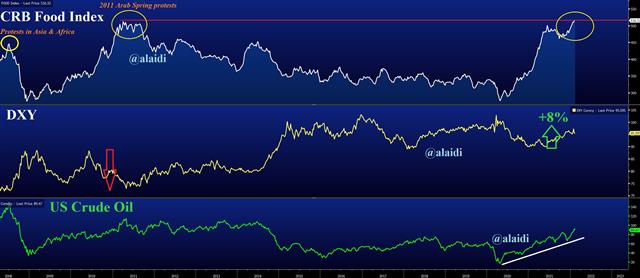Food ex USD

The 2008 record in food prices was a function of a commodity surpercycle, helped by biofuel food crises, a 40% tumble in USD and massive commodities purchases from China. The 2011 food price boom was also helped by a fresh commodities rally brought about by USD weakness and accelerating China demand for metals and energy.
WHAT HAPPENS NOW? Supply-driven pressures in energy and metals may subside, but unlikely to be reversed any time soon, owing to reduced investments and ongoing supply chain challenges.
WHAT IF if US dollar makes the transition from range-bound to outright decline due to catch-up tightening from the rest of the world and deficit obstacles to more Fed hikes. Could the food crisis be exacerbated by a weak USD?
We've definitely entered a new phase--where this is no longer about monetary policy normalization. It is about BoE's Bailey cautioning people against demanding wage hikes (he did say that), president Biden calming inflation nerves on primetime and even uber dovish ECB's Lagarde finally opened the possibility for a 2022 rate hike.
Central bank tightening is surely here to stay. As long as there policy errors from from overtightening are avoided, food prices will not be stabilising anytime soon, neither will the risk of unrest in developing nations and equity market volatility in the developed world.
Latest IMTs
-
Silver's Signal to Gold Full Explanation
by Ashraf Laidi | Dec 30, 2025 20:04
-
Gold Silver Next الذهب و الفضة
by Ashraf Laidi | Dec 26, 2025 17:15
-
Everyone's Talking about this Risk
by Ashraf Laidi | Dec 24, 2025 14:08
-
2026 Difficult but not Impossible
by Ashraf Laidi | Dec 22, 2025 20:06
-
Bank of Japan Massacre or Yawn?
by Ashraf Laidi | Dec 18, 2025 20:50







